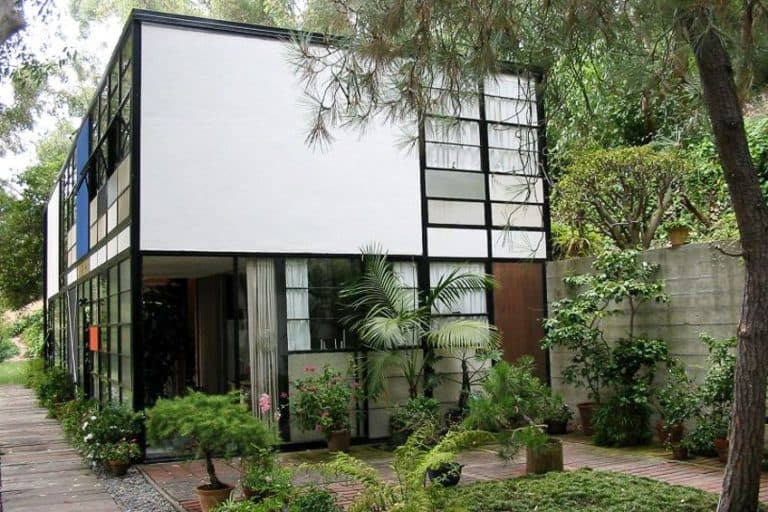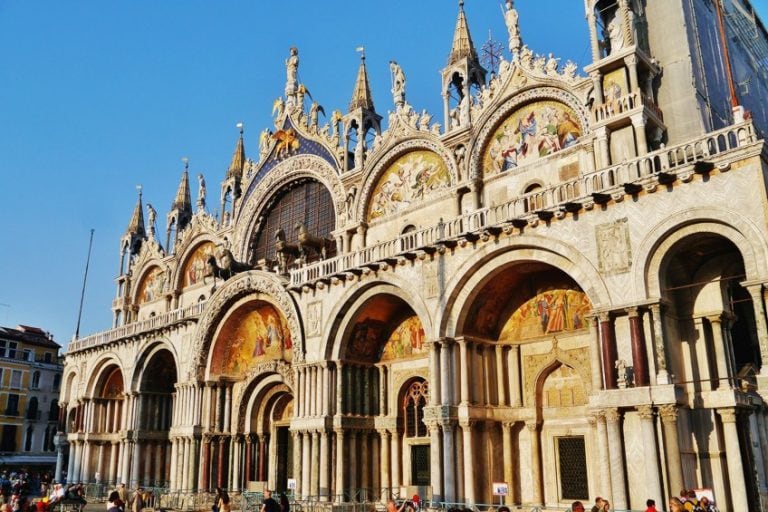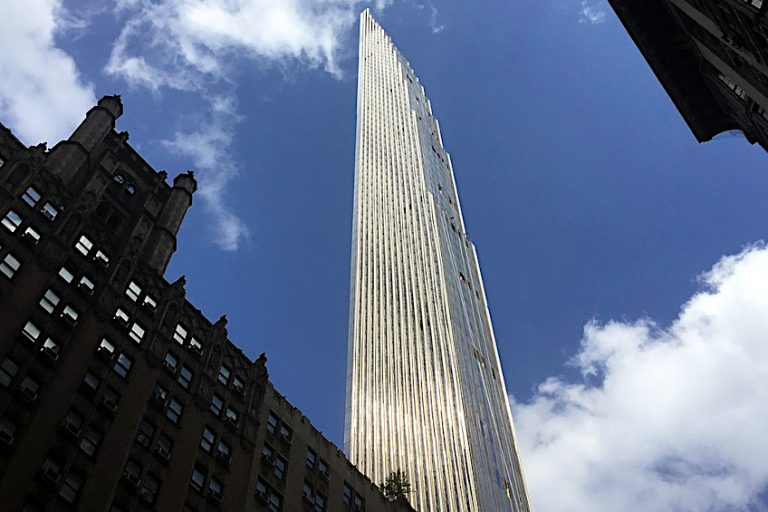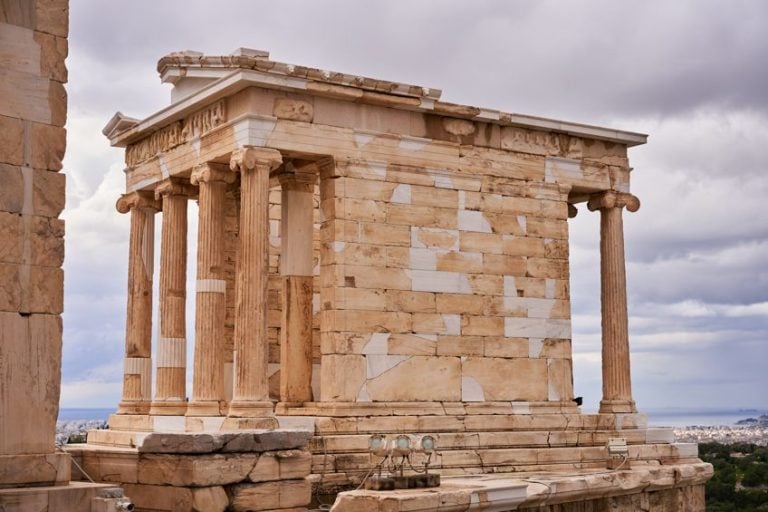Belém Tower in Lisbon – Explore the Torre de Belem
Why was the Belém Tower built and where is the Belém Tower located? The Belém Tower (or Torre de Belém in Portuguese) was constructed in Lisbon to serve as a place that Portuguese explorers could embark and disembark from the port. When was the Belém Tower built? It was built in the 16th century and also served as the ceremonial gateway to the city. As an example of Renaissance architecture in this region, this Tower was both practical and aesthetically pleasing. Let’s explore the tower in more detail below.
Exploring Belém Tower, Lisbon
| Architect | Francisco de Arruda (d. 1547) |
| Date Completed | 1519 |
| Function | Fortification |
| Location | Lisbon, Portugal |
Belém Tower was constructed at the height of the Portuguese Renaissance. Considered a prime example of the Portuguese Manueline style, it also features elements of several other architectural styles. It was constructed from Lioz (also known as Royal Stone) limestone and comprises a bastion and a four-story tower that reaches 30 meters in height. It was declared a World Heritage Site by UNESCO in 1983 and is often considered a symbol of the Age of Discoveries in Europe. An often-cited, yet incorrect theory is that it was originally constructed in the middle of the Tagus river, but found itself near the shoreline after an earthquake in 1755 redirected the river. However, the truth is that it was originally built near the shoreline on a little island in the river.
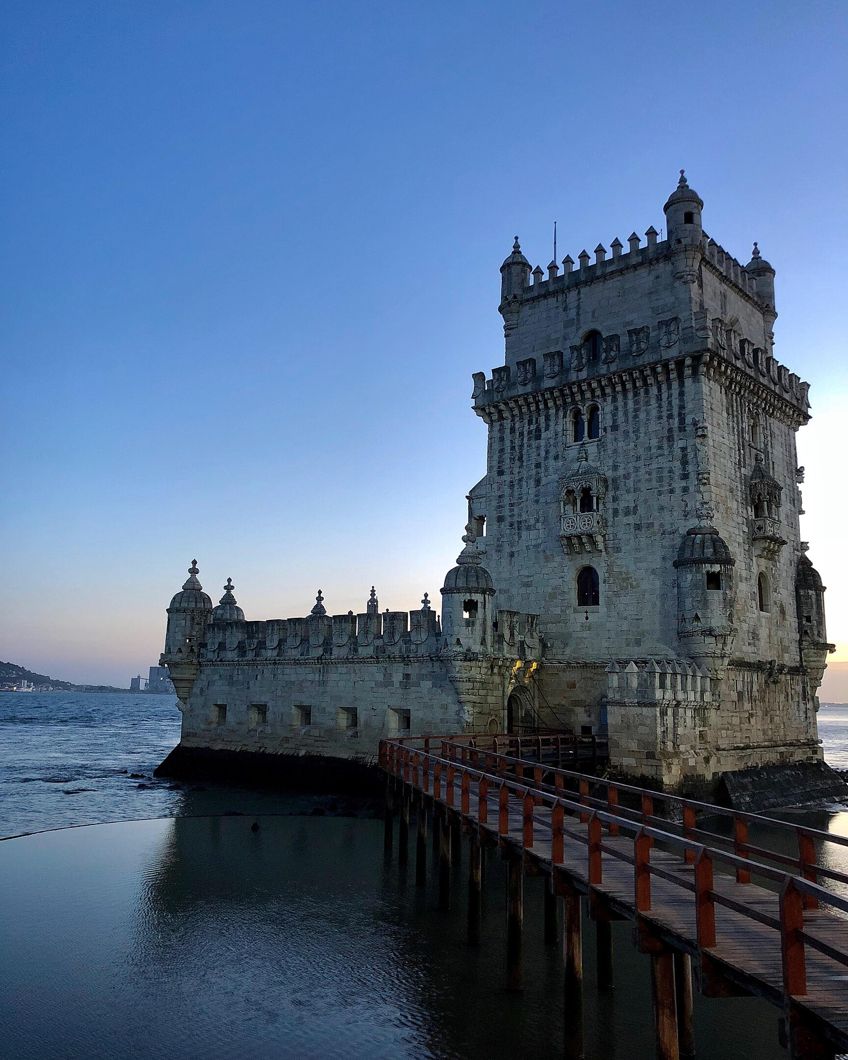 Belém Tower at Sunset (2018); Felipegtx, CC BY-SA 4.0, via Wikimedia Commons
Belém Tower at Sunset (2018); Felipegtx, CC BY-SA 4.0, via Wikimedia Commons
The History of the Belém Tower, Lisbon
King John II found it necessary to construct a defense system for the Tagus River’s mouth in the late 15th century, which had up to that point relied on the São Sebastião and Cascais fortresses for protection. However, he found these fortresses to be insufficient and decided that more security be put in place. The King ordered the design and construction of a strong fort, however, he passed away before any designs were even drawn up. Around 20 years later,
King Manuel I took another look at the proposal and decided that a military fortification was to be built on the Tagus River’s northern margin.
Initial Construction of the Tower
Utilizing some of the stones that were being gathered to construct the Monastery of Santa Maria de Belém, they started building on an outcrop of basaltic rock which was situated a close distance from the river’s banks. King Manuel appointed Francisco de Arruda, a military architect, to build the tower in 1516, sending him around 760 blocks and 500 stones to complete the project. Until the tower’s completion, a large, heavily armed ship was stationed at the mouth of the river to protect the estuary. The tower’s construction was completed in 1519, but the king died two years later and Gaspar de Paiva was commissioned to be the first Captain-General of the fortress. The monarch was then advised to improve the city’s coastal defenses by Francisco de Holanda in 1571, who further suggested that the tower be reinforced. He then built an improved bastion that featured several turrets.
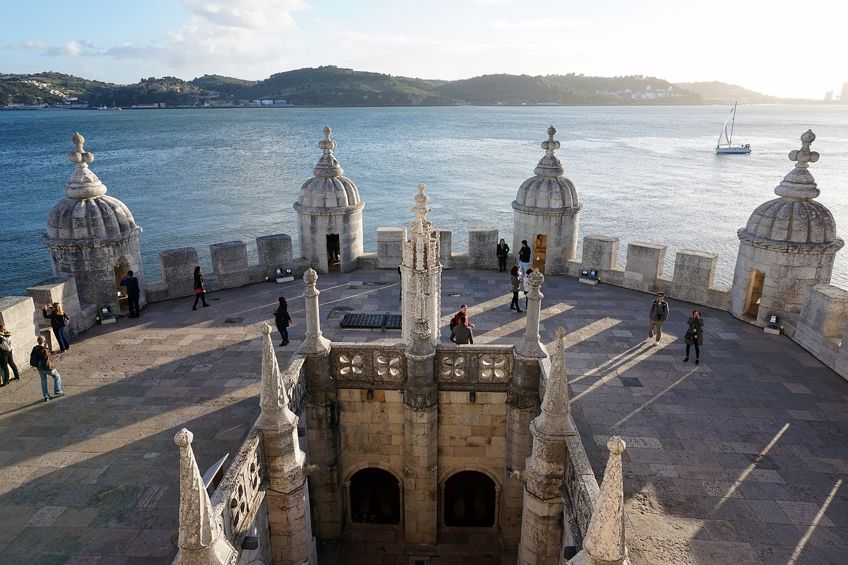 Belém Tower, Lisbon (2015); Matt Kieffer from London, United Kingdom, CC BY-SA 2.0, via Wikimedia Commons
Belém Tower, Lisbon (2015); Matt Kieffer from London, United Kingdom, CC BY-SA 2.0, via Wikimedia Commons
After the Spanish forces overtook the fort in 1580 following a few hours of battle, the tower’s dungeons were turned into a prison and functioned as such all the way up to 1830. It was also in the final years of the 16th century that the Phillippine Barracks were constructed – a two-story building that was built over the bastion, providing the look that the tower still has retained up to today, including the domed turrets and sculpted crucifixes. There were designs made by Friar João Vicenzio Casale in 1589 that would have extended the fortress considerably, but these plans, which were initiated by King Philip I never materialized.
The Role of the Tower
An inscription on the north side of the cloister which referred to the year 1655, verified the tower’s role as a customs control station and for overseeing navigation down the Tagus river; boats were required to pay a fee when they entered the harbor. General Guilherme de Valleré built the Fort of Bom Sucesso from 1780 until 1782, with its battery attached to the fortress by a corridor wall. From 1808 until 1814, when French troops attacked the city during the Peninsular War, squadrons of their soldiers were stationed in the Belém Tower in Lisbon.
Once the French forces had eventually retreated, It was advised to add additional artillery batteries on the sides of the tower, as well as along the river.
A few years later the dungeons were used to imprison the opponents of King Miguel I. Until 1833, when the tax on foreign ships was abolished, another level of the tower was used as a customs house. During Maria II’s reign, the tower had begun to deteriorate and António de Azevedo e Cunha, a military engineer, was hired to begin renovating the fortress. From 1845 to 1846, he removed the Philippine barracks and expanded revivalist features. From 1865 to 1867 a beacon was built on the tower’s southeastern terrace and a telegraph system was put in place. The Torre de Belém then slowly began to deteriorate until the first initiatives to restore and preserve it commenced in the second half of the 20th century.
Conservation of the Tower
In 1940, the responsibility of conserving the Belém Tower in Lisbon was handed over to the Ministry of Finance. They began with small conservational efforts and then the military quarters were demolished and an inner cloister was constructed. In 1953, a three-year program was undertaken by António Viana Barreto, an architectural landscape designer, to integrate the fortress with the shoreline. In 1983, it was declared a World Heritage Site by UNESCO and also hosted the European Exhibition on Art, Science, and Culture. The Instituto Português do Património Arquitectónico then took control of the tower in the 1990s and initiated a complete restoration which began in February 1997 and continued until January the following year. On the 7th of July, 2007, it was added to the list of the Seven Wonders of Portugal.
 Belem Tower Interior, Lisbon (2023); Simon Burchell, CC BY-SA 4.0, via Wikimedia Commons
Belem Tower Interior, Lisbon (2023); Simon Burchell, CC BY-SA 4.0, via Wikimedia Commons
The Architecture of the Belém Tower in Lisbon
The structure is made up of a rectangular tower and an asymmetrical, hexagonal bastion with extended sides that protrude south into the Tugres. A drawbridge used to enter the bulwark is located on the northeastern corner of the tower, surrounded by a defensive wall with bartizans. It is adorned with plant designs, is capped with a royal coat of arms, and is bordered by smaller columns covered with armillary spheres.
The elaborately carved, twisting rope and exquisite knots are other features of the Manueline style that refer to Portugal’s naval history.
The walls on the exterior of the lower bastion provide room for 17 cannons and embrasures that overlook the river. The turret bases are decorated with representations of animals, including a rhinoceros. This depiction is believed to be the earliest rhinoceros sculpture in the history of Western European art, and it most likely portrays the rhinoceros that Manuel I delivered to Pope Leo X in 1515. While the Torre de Belém is primarily Manueline in design, it also includes elements of other architectural styles, including Moroccan architecture. The exquisite ornamentation, balconies, the watchtowers’ ribbed cupolas, and arched windows all indicate the influence of Moorish architecture.
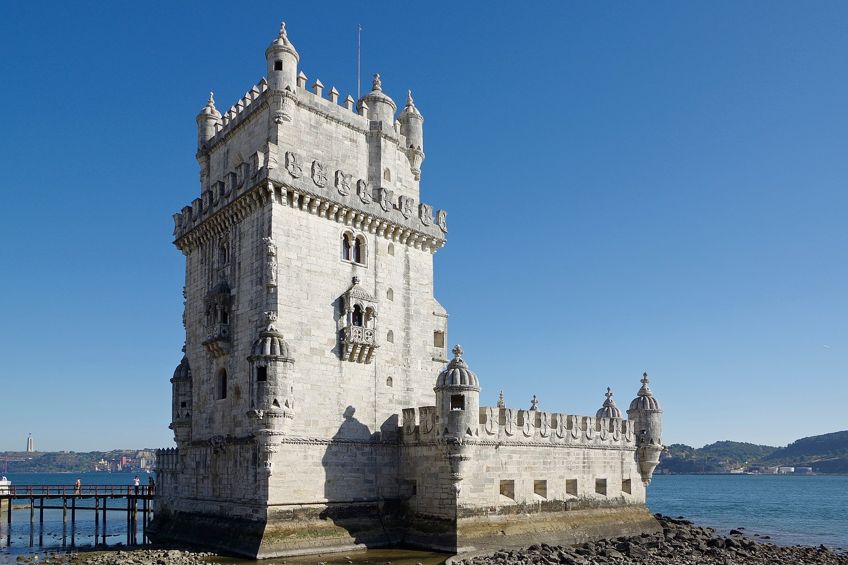 Belém Tower, Lisbon (2018); Berthold Werner, CC BY-SA 4.0, via Wikimedia Commons
Belém Tower, Lisbon (2018); Berthold Werner, CC BY-SA 4.0, via Wikimedia Commons
Belém Tower in Lisbon, built on the Tagus River’s north bank, was used to protect the city. It was eventually converted into a customs house as well as a lighthouse. Since its original construction, it has been extended, built on, and restored several times, with the last major restoration efforts occurring in the late 1990s. Today, it is one of Portugal’s Seven Wonders, as well as a World Heritage Site.
Frequently Asked Questions
Why Was the Belém Tower Built?
Due to its position along the Tagus River, the city of Lisbon was vulnerable to attack and required fortification. The defense of the city was not the only function of the tower, though, and it served as a riverside port where travelers could both enter and depart from the city. It was also used as a customs house that collected taxes from vessels wishing to use the river. At one point, a beacon was added to the tower, turning it into a lighthouse for those traveling along the river.
When Was the Belém Tower Built?
Construction on the tower began in 1515 and concluded four years later. Then, in the last years of the 16th century, the Phillippine Barracks were constructed. In the late 19th and early 20th centuries, it was renovated and expanded. Today, it is a popular tourist destination and is ranked as one of Portugal’s Seven Wonders.
Where Is the Belém Tower Located?
Belém Tower is located approximately six kilometers west of Lisbon, on the Belém coast. It is situated on the north bank of the river Tagus. Torre de Belém was placed there as the location was perfectly suited to look out over the river for any approaching attacks. There was a legend that the tower had once stood in the middle of the river but had ended up by the shoreline after the waters were diverted following an earthquake. This is not true, though, as Belém Tower was originally built on an outcrop of basaltic rock that was located just a bit beyond the riverbanks.
Justin van Huyssteen is a freelance writer, novelist, and academic originally from Cape Town, South Africa. At present, he has a bachelor’s degree in English and literary theory and an honor’s degree in literary theory. He is currently working towards his master’s degree in literary theory with a focus on animal studies, critical theory, and semiotics within literature. As a novelist and freelancer, he often writes under the pen name L.C. Lupus.
Justin’s preferred literary movements include modern and postmodern literature with literary fiction and genre fiction like sci-fi, post-apocalyptic, and horror being of particular interest. His academia extends to his interest in prose and narratology. He enjoys analyzing a variety of mediums through a literary lens, such as graphic novels, film, and video games.
Justin is working for artincontext.org as an author and content writer since 2022. He is responsible for all blog posts about architecture, literature and poetry.
Learn more about Justin van Huyssteen and the Art in Context Team.
Cite this Article
Justin, van Huyssteen, “Belém Tower in Lisbon – Explore the Torre de Belem.” Art in Context. May 10, 2023. URL: https://artincontext.org/belem-tower-in-lisbon/
van Huyssteen, J. (2023, 10 May). Belém Tower in Lisbon – Explore the Torre de Belem. Art in Context. https://artincontext.org/belem-tower-in-lisbon/
van Huyssteen, Justin. “Belém Tower in Lisbon – Explore the Torre de Belem.” Art in Context, May 10, 2023. https://artincontext.org/belem-tower-in-lisbon/.



